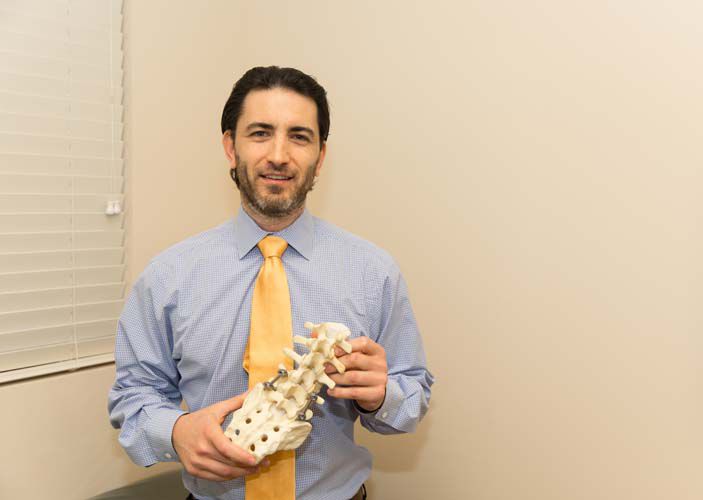
Twenty years ago, spinal surgery had a reputation for often causing as much – or more – pain than it helped to relieve.
That’s not the case today, according to Dr. David Vecchione, an enthusiastic young orthopedic surgeon with Sebastian River Medical Center whose offices are in Vero Beach.
Two specific procedures – the “anterior cervical discectomy” and the “lumbar laminectomy” – are of particular interest to Vecchione – although this 35-year-old surgeon says he actually spends a great deal of his time talking some patients out of surgery.
“If a patient comes in with neck pain or back pain and nothing else,” says Vecchione, “a lot of times they’ll tell me, ‘You need to operate on my back. You need to fix my back,’ but a lot of times, that really isn’t the way to go.”
“Usually I’ll get an X-ray the first time I see a patient just to get a baseline of how their bones move [and] if they’re moving back and forth [and] if I can find an instability in their spine,” Vecchione explains. “Then I’ll get an MRI to check on how much compression is on the spinal cord and nerves coming out of the side of the cord.”
“There’s always a progression of types of treatment,” Vecchione continues, adding that “usually physical therapy will be the first thing” he recommends.
If that doesn’t work, Vecchione might turn to anti-inflammatory drugs or a steroid injection. “Most of the time,” he says, “a steroid right at the level that’s symptomatic whether it be in the neck or the back can help.”
If surgery is finally determined to be the best course of treatment, Vecchione switches into surgeon mode and starts educating his patients on their personal pathology, the specifics of the procedure and what that patient can expect both during and after surgery.
An anterior cervical discectomy (ACD), for example, “is one of the most prevalent spine surgeries performed to treat a variety of disorders in the cervical (neck area) of the spine,” according to the National Institutes of Health.
It is now performed largely on an outpatient basis thanks to newer, less-invasive techniques, and is designed to treat nerve root or spinal cord compression.
The word “discectomy” literally means “cutting out the disc.”
In an ACD, according to the Mayfield Clinic of Cincinnati, Ohio, “the surgeon reaches the damaged disc from the front of the spine through the throat area. By moving aside the neck muscles, trachea and esophagus, the disc and bony vertebrae are exposed. Depending on the patient’s particular symptoms, one disc or more discs may be removed.”
After a disc is removed, a space-holding bone graft may be inserted to fill the open space to prevent future nerve compression.
A “lumbar laminectomy,” meanwhile, is a lower back procedure which enlarges the spinal canal by removing the lamina, which is the back part of the vertebra that covers the spinal canal. Its goal is to relieve pressure on the spinal cord or nerves.
According to the Mayo Clinic, “That pressure is most commonly caused by bony overgrowths within the spinal canal, which can occur in people who have arthritis in their spines.”
Vecchione describes the procedure this way: “We’ll go in, remove the bone off the back of the spine and then get access to the soft tissue that’s overgrowing. We’ll remove the soft tissue and that lets you get access to the hole where the nerve is running out on both sides. Then I have small instruments – little hooks and little biters – that I can slip over the nerve and cut out the overgrown bone … and make sure the nerve is now free.”
WebMD, however, warns the procedure “can also make your spine less stable. If that happens, you’ll probably need a spinal fusion.”
In a spinal fusion, the Mayo Clinic explains, “the surgeon places bone or a bonelike material within the space between two spinal vertebrae. Metal plates, screws and rods may be used to hold the vertebrae together, so they can heal into one solid unit.”
No surgery – and especially spinal surgery – should be entered into lightly.
Moreover, surgery is not a time machine. As Vecchione points out, older patients with multiple arthritic problems will very likely not get 100 percent relief from any one procedure so it’s important to have an in-depth discussion about what to expect with your doctor.
Dr. David Vecchione is an orthopedic surgeon with the Sebastian River Medical Center. His offices are at 1715 37th Place in Vero Beach. The phone number is 772-778-0600.



